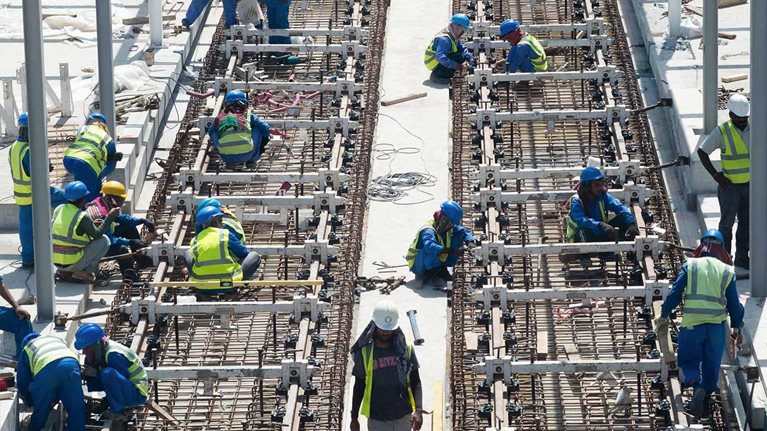Ride America’s highways, byways, and rails, and one thing becomes clear: in many places, the country’s transportation infrastructure is aging and declining in quality. The same could be said of the country’s sewers, ports, and electric grid. Overall, the American Society of Civil Engineers gives US infrastructure a grade of D+. And things will not necessarily get better, because population and economic growth are putting more stress on everything from dams to airports.
Stay current on your favorite topics
Inadequate infrastructure not only affects Americans’ quality of life; it is also bad for business. McKinsey Global Institute estimates that for the United States to sustain its economic growth, an additional $120 billion needs to be spent in 2017 alone—and $150 billion more per year by 2030.
Money is necessary, but it is not enough. Here are four steps that could help transform infrastructure delivery.
Establish a clear point of accountability within the federal government
There are many overlapping federal agencies, processes, and roles with oversight into how projects are approved, managed, and funded. The situation is different for every asset class. Overlapping and competing regulations and processes can extend schedules, increase costs, and reduce investment returns. For example, according to the US Department of Transportation, it takes an average of 13 years to build a major highway project, from idea to completion.
There is an opportunity to learn from how other democracies have improved decision processes to move projects through the pipeline at much greater speed, while ensuring projects are properly reviewed and environmental concerns are mitigated. The national government of Australia, for example, created a national infrastructure body, Infrastructure Australia, and charged it with reducing regulatory burdens while still prioritizing environmental and safety considerations. Australia cut the number of procedures for obtaining a construction permit from 25 to 14 and the average permit processing time from 150 to 112 days. In other countries, similar entities can be found at the state or provincial level; Canada’s Infrastructure Ontario, for example, has built more than 30 hospitals on time and on budget.
The US federal government could also help catalyze better performance from the construction industry. Meanwhile, US construction labor productivity is lower today than it was in 1968, even as all other major industrial sectors have experienced impressive gains. A national effort to implement programs and incentives that could systematically unlock productivity-enhancing innovations would clearly improve the current situation.
Focus on outcomes; define performance metrics
Infrastructure can be an incredible enabler of such aspirations as economic growth, greater access to jobs and healthcare, increased interstate commerce, or access to broadband. It is through such an outcome-focused lens that the federal government could identify nationally significant projects. Today’s approach, however, focuses almost exclusively on inputs, such as planning, procurement, and permitting.
Would you like to learn more about our Capital Projects & Infrastructure Practice?
To set priorities and better evaluate potential outcomes, the federal government could set a formula for calculating projects’ economic and social impacts, and a system for measuring and reporting performance. The cost of each project can then be compared with these benefits, in turn helping determine the order of priority. This would help ensure the right projects are supported from all levels of government and the private sector.
A transparent pipeline of well-planned projects, with appropriate risk-adjusted returns, could help to attract public and private investment. Moreover, this predictability and clarity could reduce the rate of return private investors require in order to make infrastructure investments, lowering the cost of capital.
Large-scale, multistate projects often bring the biggest payoff. However, these can also be especially difficult to deliver. Costs are shared unequally, regulations can vary, benefits may not be evenly distributed, and there are likely multiple stakeholders with varying interests. One example is the Gateway Program, which aims to double rail capacity between urban centers in New York and New Jersey, ultimately improving rail service from Boston to Washington DC. Gateway could improve mobility and foster enormous economic benefits for the whole region. Given how critical urban areas are to the US economy, and the New York region in particular, this could also be seen as a national imperative. The fact that there are many stakeholders, however, makes it difficult.
The federal government could also establish a common set of performance measurements for major infrastructure projects, applied using a central system for reporting and public disclosure. Experience in other countries shows that when the costs and progress of large capital projects are more transparent, costs come down.
Empower and support state and local experiments
Some of the most notable recent infrastructure projects were led by local leaders. They succeeded in spite of the challenges, including cumbersome and inconsistent procurement and permitting processes, skills gaps in the workforce, and limited sharing of best practices.
The federal government could partner with state and local governments to overcome some of these issues. For example, it could collect and share examples of best practices and innovations that are working in different sectors or regions. It could also draw from the private sector, where companies have made significant advances in areas from procurement efficiency to the application of advanced analytics to evaluate user experiences.

Voices on Infrastructure
Besides better building, there is an opportunity to operate and upgrade existing assets more efficiently. The federal government could provide financial and regulatory incentives for states and cities to more rapidly deploy smart solutions like demand-based pricing and the use of Internet of Things technology to evaluate problems, improve the physical quality of assets, and manage performance in real time.
Improve funding and financing processes
Private investors, such as insurers, pension funds, and sovereign wealth funds, manage approximately $120 trillion in assets, and they are looking for solid long-term investments. Yet many have avoided investing in US infrastructure, seeing the sector as complex, uncertain, and risky. We expect that more capital would flow if investing in infrastructure were simpler, faster, and more transparent. The three previous steps could help get there.
Additionally, the federal government could consider providing an incentive to states that monetize existing infrastructure assets and invest the money in new projects. This can take many forms—some may be sold entirely, others may incorporate revenue-generating features such as tolls, and others might be partly sold or change their financial model. For example, the government could rent out space in under- or unutilized buildings. The incentives could be financial or even in the form of opportunities, such as the chance to take part in a new pilot program or receive funding for a new technology.
There is a massive amount of public equity tied up in existing assets that could quickly be deployed to advance new projects. Australia has spurred significant increases in infrastructure investment since its federal government began offering a 15 percent premium to states that monetize an asset, as long as the proceeds go to new infrastructure.
Our research suggests that every dollar of US infrastructure investment can raise GDP by an additional 20 cents, as long as the investment is sound. An outcome-focused approach to America’s national infrastructure could help ensure the investment is directed toward projects that offer significant economic and social benefits and that are planned, built, and operated efficiently.
A version of this article appeared in TIME Magazine.


